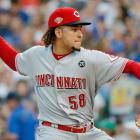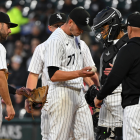Commanding the strike zone is everything in baseball. The hitters who do it have success -- a lot of success -- and the pitchers who do it have a lot of success too. For a pitcher, commanding the strike zone does not mean simply throwing strikes. It means throwing quality strikes. The ability to pitch on the edges or even just off the plate. That's commanding the zone.
Last week we examined three position players who improved their defense last season. This week we're going to look at pitchers who commanded the strike zone and excelled at getting hitters to chase out of the zone in 2019. It's not easy to square a pitch up, or even get the bat on it, when you have to reach for it.
Reds right-hander Luis Castillo is one of the more fascinating pitchers in the game. He's been traded four times, including from the Marlins to the Padres and then back to the Marlins three days later, and his changeup is as nasty as it gets. It might be the best right-handed changeup since Trevor Hoffman. It's that good. To wit:
Two Minutes of Luis Castillo's Changeups.
— SnorlaxIsMyDaddy (@PitchingNinja) May 2, 2020
The most exciting 2 minutes in sports...since the Kentucky Derby is canceled. 🏇 pic.twitter.com/TbU51YBZOw
Last season Castillo, who is still only 27, broke out as an ace-caliber starter despite throwing far fewer pitches in the strike zone. He threw 48.2 percent of his pitches in the zone in 2018, well above the 41.8 percent league average. Last year Castillo's zone rate plunged to 39.3 percent. The 8.0 percentage point drop was the largest in baseball.
Fewer pitches in the strike zone led to an increase in walk rate, unsurprisingly. Castillo's 3.2 percentage point increase in walk rate (6.9 percent in 2018 to 10.1 percent in 2019) was the largest in baseball. More pitches out of the zone is not necessarily a bad thing, however. Castillo's pitches (his changeup, in particular) move so much that they still generate swings when off the plate.
Hitters swung at 36.5 percent of Castillo's pitches out of the zone last year, the sixth highest chase rate in baseball. When hitters swing at pitches out of the zone, two things then to happen. Either they swing and miss because they can't reach the ball, or they make weak contact because they can't square it up. Castillo had big strikeout and exit velocity improvements last season:
| Zone % | Chase % | Strikeout % | Exit velocity | Hard-hit rate | |
|---|---|---|---|---|---|
2018 | 48.2% | 32.9% | 23.3% | 88.1 mph | 39.5% |
2019 | 39.3% | 36.2% | 28.9% | 86.4 mph | 33.6% |
Change | -8.9% | +3.3% | +5.6% | -1.7 mph | -5.9% |
Castillo allowed 13 fewer runs in 2019 than 2020 despite throwing 21 more innings. Throwing more pitches out of the strike zone led to more walks, sure, but his stuff is so good -- go watch that video again, Castillo could throw his changeup down the middle and the natural movement will carry it out of the zone -- that hitters chased often, leading to more strikeouts and a lot of weak contact.
There is perhaps room for Castillo to throw a few more strikes going forward. He might be able to cut that walk rate a bit without really cutting into his strikeout rate or weak contact allowed. That's the next goal in his development. Maintaining that elite chase rate without a big walk rate similar to chase-rate gods like Jacob deGrom, Stephen Strasburg, and Justin Verlander.
"I try to set goals every year," Castillo told the Associated Press in spring training. "Even though I got those two goals (start Opening Day and make the All-Star Game in 2019), I want to get three goals. I want to get three goals and add the Cy Young and make the playoff. I think with this team filled with veterans, it is something we can do together."
Joe Musgrove is a popular pitcher around these parts. The Pirates righty is a trendy breakout pick for many reasons, including his ability to get hitters to chase out of his strike zone. His 36.2 percent chase rate last year was identical to Castillo's and also down a tick from 37.7 percent in 2018. Even though he doesn't have overwhelming stuff, Musgrove gets hitters to expand the zone.
Musgrove's ability to induce swings on pitches out of the zone stems from a deep arsenal, specifically two high-spin breaking balls (curveball and slider) and a changeup that falls off the table. He also changed his arm action last year and regained some of the velocity he lost early in the season. That gives hitters less time to react and gives Musgrove more margin for error.
There is reason to believe Musgrove can up his chase rate even more going forward. Former Pirates pitching coach Ray Searage emphasized an old school "pound the bottom of the zone with fastballs to get quick ground balls" approach. Oscar Marin, the club's new pitching coach, is more analytically inclined. Expect to see Musgrove spin those breaking balls out of the zone more often.
"Last year, it seemed like we were trying to go in an analytical route with the Rapsodo and the numbers and the information that was made available to us, but some of it was getting lost in translation from the analytical guys to the players," Musgrove said in February. "Having a pitching coach that we spend every day with and we talk with and see and communicate with regularly, him being educated in that department is huge for us. Now we have multiple lines of communication, and we have constant feedback."
The Pirates have had a few too many pitchers with high-end underlying skills get away and reach their ceiling elsewhere in recent years (Gerrit Cole, Tyler Glasnow, Charlie Morton, etc.). Musgrove has shown similar traits with his secondary pitches and ability to get hitters to expand the zone. There's room for growth here, and the Pirates are hoping Marin will help Musgrove put it all together in their uniform.
In an era of big strikeout totals and blow-you-away fastballs, Yankees righty Masahiro Tanaka zigs when everyone else zags. He has average fastball velocity and he's thrown that fastball less than any non-knuckleballer in baseball the last few seasons. Tanaka instead lulls hitters to sleep with an array of sliders and splitters, with a few curveballs mixed in for good measure.
Thanks to those quality offspeed pitches, Tanaka is baseball's preeminent chase rate pitcher. His chase rates the last five seasons:
- 2015: 39.0 percent (second highest in MLB)
- 2016: 37.8 percent (fourth highest in MLB)
- 2017: 42.2 percent (highest in MLB)
- 2018: 40.7 percent (highest in MLB)
- 2019: 39.9 percent (highest in MLB)
Tanaka's 40.0 percent chase rate from 2015-19 is the highest in baseball by a good margin. Carlos Carrasco is second at 37.5 percent. The gap between No. 1 and No. 2 is the same as the gap between No. 2 and No. 12. The fact Tanaka has posted a career 4.9 percent walk rate despite relying so much on getting hitters to expand the zone is remarkable. It really is.
Even though he had baseball's highest chase rate last season, Tanaka's chase rate was down from the two prior years, and it's not a coincidence that happened in a season he had a hard time with the baseball. Tanaka had to change the grip on his splitter, his trademark pitch, because the baseball was so slick.
"I've always, up to this point, tried to stick with the grip that I've always used for the splitter and made small adjustments in order to get the movement that I want,'' Tanaka told the New York Post last July. "You get good results and bad results and the difference between the two are so big. When it's good, it's really good, but when it's bad, obviously, it's been very bad. I thought I needed to make a different type adjustment here. That's the biggest reason I went to something as drastic as changing the grip."
Tanaka's margin for error is not very big because he can't always reach back and throw a fastball by a hitter when he's in a jam. If he doesn't have his secondary pitches working, hitters won't chase. That's why he had a 4.79 ERA in 21 starts with his old splitter grip last season and a much more palatable 3.79 ERA in his final 10 starts with the new grip.
We have no idea how the baseball will play in 2020. If it shows the same characteristics as the 2019 ball, Tanaka could continue to struggle with his splitter, and his chase rate could slip even more. If the ball has more tack and Tanaka gets his splitter back, his chase rate could climb back to where it was in 2017. The baseball factors into Tanaka's performance more than most.


























